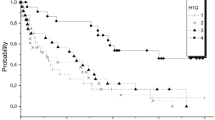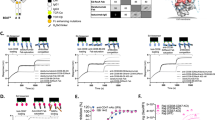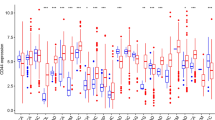Abstract
Expression of CD44v9-containing isoforms (CD44v9) on myeloma plasma cells correlates with unfavorable prognosis, suggesting that CD44 variant molecules are involved in the disease process. In this study, the presence of CD44v on B cell lines from different stages of development was analyzed by flow cytometry and a role in adhesion to stromal cells from different tissues was evaluated in in vitro binding assays. CD44v3, v6 and v9 isoforms were exclusively expressed on plasma cell lines and CD44v9 expression correlated with IL-6-dependent plasma cell growth. Binding studies using CD44 isoform- specific reagents showed that CD44v6 and CD44v9 were involved in binding to bone marrow stromal cells, but not to in vitro synthesized ECM or hyaluronic acid. CD44v9-mediated plasma cell binding resulted in a significant induction of IL-6 secretion by bone marrow stromal cells. Large differences in quantitative plasma cell binding to stromal cells from different tissues were observed. These, however, could not be related to a differential use of CD44v in these binding processes. The role of CD44v9 in adhesion induced IL-6 secretion and its preferential expression on IL-6-dependent plasma cell lines may explain the previously observed correlation between CD44v9 expression and adverse prognosis in multiple myeloma.
This is a preview of subscription content, access via your institution
Access options
Subscribe to this journal
Receive 12 print issues and online access
$259.00 per year
only $21.58 per issue
Buy this article
- Purchase on SpringerLink
- Instant access to full article PDF
Prices may be subject to local taxes which are calculated during checkout






Similar content being viewed by others
References
Hallek M, Bergsagel PL, Anderson KC . Multiple myeloma: increasing evidence for a multistep transformation process Blood 1998 91: 3–21
Van Camp B, Durie BGM, Spier C, de Waele M, van Riet I, Vela E, Frutiger Y, Richter L, Grogan TM . Plasma cells in multiple myeloma express a natural killer cell-associated antigen: CD56 (NKH-1; Leu-19) Blood 1990 76: 377–382
Uchiyama H, Barut BA, Chauhan D, Cannistra SA, Anderson KC . Characterization of adhesion molecules on human myeloma cell lines Blood 1992 80: 2306–2314
Ahsmann EJM, Lokhorst HM, Dekker AW, Bloem AC . Lymphocyte function-associated antigen-1 expression on plasma cells correlates with tumor growth in multiple myeloma Blood 1992 79: 2068–2075
Huang N, Kawano MM, Harada H, Harada Y, Sakai A, Kuramoto A, Niwa O . Heterogeneous expression of a novel MPC-1 antigen on myeloma cells: possible involvement of the MPC-1 antigen in the adhesion of mature myeloma cells to bone marrow stromal cells Blood 1993 82: 3721–3729
Ridley RC, Xiao H, Hata H, Woodliff J, Epstein J, Sanderson RD . Expression of syndecan regulates human myeloma plasma cell adhesion to type I collagen Blood 1993 81: 767–774
Lokhorst HM, Lamme T, de Smet M, Klein S, de Weger RA, van Oers R, Bloem AC . Primary tumor cells of myeloma patients induce interleukin-6 secretion in long-term bone marrow cultures Blood 1994 84: 2269–2277
Pellat-Deceunynck C, Barillé S, Puthier D, Rapp MJ, Harousseau JL, Bataille R, Amiot M . Adhesion molecules on human myeloma cells: significant changes in expression related to malignancy, tumor spreading, and immortalization Cancer Res 1995 55: 3647–3653
Huang NH, Kawano MM, Mahmoud MS, Mihara K, Tsujimoto T, Niwa O, Kuramoto A . Expression of CD21 antigen on myeloma cells and its involvement in their adhesion to bone marrow stromal cells Blood 1995 85: 3704–3712
Masellis-Smith A, Belch AR, Mant MJ, Turley EA, Pilarski LM . Hyaluronan-dependent motility of B cells and leukemic plasma cells in blood, but not of bone marrow plasma cells, in multiple myeloma: alternate use of receptor for hyaluronan-mediated motility (RHAMM) and CD44 Blood 1996 87: 1891–1899
Teoh G, Urashima M, Greenfield EA, Nguyen KA, Lee JF, Chauhan D, Ogata A, Treon SP, Anderson KC . The 86-kD subunit of Ku autoantigen mediates homotypic and heterotypic adhesion of multiple myeloma cells J Clin Invest 1998 101: 1379–1388
Uchiyama H, Barut BA, Mohrbacher AF, Chauhan D, Anderson KC . Adhesion of human myeloma derived cell lines to bone marrow stromal cells stimulates interleukin-6 secretion Blood 1993 82: 3712–3720
Barillé S, Collette M, Bataille R, Amiot M . Myeloma cells upregulate interleukin-6 secretion in osteoblastic cells through cell-to-cell contact but downregulate osteocalcin Blood 1995 86: 3151–3159
Klein B, Zhang XG, Jourdan M, Boiron JM, Portier M, Lu ZY, Wijdenes J, Brochier J, Bataille R . Interleukin-6 is the central tumour growth factor in vitro and in vivo in multiple myeloma Eur Cytokine Netw 1990 1: 193–201
Günthert U . CD44: a multitude of isoforms with diverse functions Curr Top Microbiol Immunol 1993 184: 47–63
Stauder R, van Driel M, Schwärzler C, Thaler J, Lokhorst HM, Kreuser ED, Bloem AC, Günthert U, Eisterer W . Different CD44 splicing patterns define prognostic subgroups in multiple myeloma Blood 1996 88: 3101–3108
Van Driel M, Günthert U, Stauder R, Joling P, Lokhorst HM, Bloem AC . CD44 isoforms distinguish between bone marrow plasma cells from normal individuals and patients with multiple myeloma at different stages of disease Leukemia 1998 12: 1821–1828
Lesley J, Hyman R, Kincade P-W . CD44 and its interaction with extracellular matrix Adv Immunol 1993 54: 271–335
De Grendele HC, Estess P, Siegelman MH . Requirement for CD44 in activated T cell extravasation into an inflammatory site Science 1997 278: 672–675
Miyake K, Medina KL, Hayashi SI, Ono S, Hamaoka T, Kincade PW . Monoclonal antibodies to Pgp-1/CD44 block lympho-hemopoiesis in long-term bone marrow cultures J Exp Med 1990 171: 477–488
Stauder R, Günthert U . CD44 isoforms – impact on lymphocyte activation and differentiation Immunologist 1995 3: 26–31
Galluzzo E, Albi N, Fiorucci S, Merigiola C, Ruggeri L, Tosti A, Grossi CE, Velardi A . Involvement of CD44 variant isoforms in hyaluronate adhesion by human activated T cells Eur J Immunol 1995 25: 2932–2939
Haegel-Kronenberger H, de la Salle H, Bohbot A, Oberling F, Cazenave JP, Hanau D . Adhesive and/or signaling functions of CD44 isoforms in human dendritic cells J Immunol 1998 161: 3902–3911
Yu Q, Toole BP, Stamenkovic I . Induction of apoptosis of metastatic mammary carcinoma cells in vivo by disruption of tumor cell surface CD44 function J Exp Med 1997 186: 1985–1996
Günthert U, Hofmann M, Rudy W, Reber S, Zöller M, Haussman I, Matzku S, Wenzel A, Ponta H, Herrlich P . A new variant of glycoprotein CD44 confers metastatic potential to rat carcinoma cells Cell 1991 65: 13–24
Stauder R, Eisterer W, Thaler J, Günthert U . CD44 variant isoforms in non-Hodgkin's lymphoma: a new independent prognostic factor Blood 1995 85: 2885–2899
Legras S, Günthert U, Stauder R et al. A strong expression of CD44–6v correlates with shorter survival of patients with acute myeloid leukemia Blood 1998 91: 3401–3413
Wielenga VJ, Heider KH, Offerhaus GJ, Adolf GR, van den Berg FM, Ponta H, Herrlich P, Pals ST . Expression of CD44 variant proteins in human colorectal cancer is related to tumor progression Cancer Res 1993 53: 4754–4756
Aruffo A, Stamenkovic I, Melnick M, Underhill CB, Seed B . CD44 is the principal cell surface receptor for hyaluronate Cell 1990 61: 1303–1313
Jalkanen S, Jalkanen M . Lymphocyte CD44 binds the COOH-terminal heparin-binding domain of fibronectin J Cell Biol 1992 116: 817–825
Carter WG, Wayner EA . Characterization of the class III collagen receptor, a phosphorylated, transmembrane glycoprotein expressed in nucleated human cells J Biol Chem 1988 263: 4193–4201
Ishii S, Ford R, Thomas P, Nachman A, Steele G Jr, Jessup JM . CD44 participates in the adhesion of human colorectal carcinoma cells to laminin and type IV collagen Surg Oncol 1993 2: 255–264
Weber GF, Ashkar S, Glimcher MJ, Cantor H . Receptor-ligand interaction between CD44 and osteopontin (Eta-1) Science 1996 271: 509–512
Toyama-Sorimachi N, Sorimachi H, Tobita Y, Kitamura F, Yagita H, Suzuki K, Miyasaka M . A novel ligand for CD44 is serglycin, a hematopoietic cell lineage-specific proteoglycan – possible involvement in lymphoid cell adherence and activation J Biol Chem 1995 270: 7437–7444
Naujokas MF, Morin M, Anderson MS, Peterson M, Miller J . The chondroitin sulfate form of invariant chain can enhance stimulation of T cell responses through interaction with CD44 Cell 1993 74: 257–268
Durie BGM, Salmon SE . A clinical staging system for multiple myeloma. Correlation of measured myeloma cell mass with presenting clinical features, response to treatment and survival Cancer 1975 36: 842–854
Van de Griend RJ, Giphart MJ, van Krimpen BA, Bolhuis RLH . Human T cell clones exerting multiple cytolytic activities show heterogeneity in susceptibility to inhibition by monoclonal antibodies J Immunol 1984 133: 1222–1229
Bloem AC, Lamme T, de Smet M, Kok H, Vooijs W, Wijdenes J, Boom SE, Lokhorst HM . Long-term bone marrow cultured stromal cells regulate myeloma tumour growth in vitro: studies with primary tumour cells and LTBMC-dependent cell lines Br J Haematol 1998 100: 166–175
Kubonishi I, Masao S, Shimamura T, Enzan H, Miyoshi I . The establishment of an interleukin-6 dependent myeloma cell line (FLAM-76) carrying t(11;14)(q13;q32) chromosome abnormality from an aggressive nonsecretory plasma cell leukemia Cancer 1992 70: 1528–1535
Zhang XG, Gaillard JP, Robillard N, Lu ZY, Gu ZJ, Jourdan M, Boiron JM, Bataille R, Klein B . Reproducible obtaining of human myeloma cell lines as a model for tumor stem cell study in human multiple myeloma Blood 1994 83: 3654–3663
Mackay CR, Terpe HJ, Stauder R, Marston WL, Stark H, Günthert U . Expression and modulation of CD44 variant isoforms in humans J Cell Biol 1994 124: 71–82
Wittig B, Schwärzler C, Föhr N, Günthert U, Zöller M . Cutting edge: curative treatment of an experimentally induced colitis by a CD44 variant v7-specific antibody J Immunol 1998 161: 1069–1073
Kansas GS, Wood GS, Dialey MO . A family of cell-surface glycoproteins defined by a putative anti-endothelial cell receptor antibody in man J Immunol 1989 142: 3050–3062
Ahsmann EJM, Benschop RJ, de Gruyl TD, Faber JAJ, Lokhorst HM, Bloem AC . A novel flow cytometric assay for the quantification of adhesion of subsets within a heterogeneous cell population; analysis of lymphocyte function-associated antigen-1 (LFA-1)-mediated binding of bone marrow-derived primary tumour cells of patients with multiple myeloma Clin Exp Immunol 1993 93: 456–463
Ahsmann EJM, Boom SE, Lokhorst HM, Rijksen G, Bloem AC . Anti-adhesive signals are mediated via major histocompatibility complex class II molecules in normal and neoplastic human B cells: correlation with B cell differentiation Eur J Immunol 1997 27: 2688–2695
Aznar-Salatti J, Bastida E, Has TE, Escolar G, Ordinas A, de Groot PG, Buchanan MR . Platelet adhesion to exposed endothelial cell extracellular matrixes is influenced by the method of preparation Arterioscler Thromb 1991 11: 436–442
Wu YP, Sixma JJ, de Groot PG . Cultured endothelial cells regulate platelet adhesion to their extracellular matrix by regulating its von Willebrand factor content Thromb Haemost 1995 73: 713–718
Sakariassen KB, Banga JD, de Groot PG, Sixma JJ . Comparison of platelet interaction of subendothelium of human renal and umbilical arteries and the extracellular matrix produced by human venous endothelial cells Thromb Haemost 1984 52: 60–65
Hansen MB, Nielsen SE, Berg K . Re-examination and further development of a precize and rapid dye method for measuring cell growth/cell kill J Immunol Methods 1989 119: 203–210
Guo MM, Hildreth JEK . Assessment of cell binding to hyaluronic acid in a solid-phase assay Anal Biochem 1996 233: 216–220
Naor DN, Sionov RV, Ish-Shalom D . CD44: structure, function, and association with the malignant process Adv Cancer Res 1997 71: 241–319
Lesly J, Hyman R . CD44 structure and function Front Biosci 1998 3: D616–630
Peach RJ, Hollenbaugh D, Stamenkovic I, Aruffo A . Identification of hyaluronic acid binding sites in the extracellular domain of CD44 J Cell Biol 1993 122: 257–264
Van der Voort R, Manten-Horst E, Smit L, Ostermann E, van den Berg F, Pals ST . Binding of cell-surface expressed CD44 to hyaluronate is dependent on splicing and cell type Biochem Biophys Res Commun 1995 214: 137–144
Bartolazzi A, Nocks A, Aruffo A, Spring F, Stamenkovic I . Glycosylation of CD44 is implicated in CD44-mediated cell adhesion to hyaluronan J Cell Biol 1996 132: 1199–1208
Takahashi K, Stamenkovic I, Cutler M, Dasgupta A, Tanabe KK . Keratan sulfate modification of CD44 modulates adhesion to hyaluronate J Biol Chem 1996 271: 9490–9496
Maiti A, Maki G, Johnson P . TNF-alpha induction of CD44-mediated leukocyte adhesion by sulphation Science 1998 282: 941–943
Droll A, Dougherty ST, Chiu RK, Dirks JF, McBride WH, Cooper DL, Dougherty GJ . Adhesive interactions between alternatively spliced CD44 isoforms J Biol Chem 1995 270: 11567–11573
Chiu RK, Droll A, Dougherty ST, Carpenito C, Cooper DL, Dougherty GJ . Alternatively spliced CD44 isoforms containing exon v10 promote cellular adhesion through the recognition of chondroitin sulfate-modified CD44 Exp Cell Res 1999 248: 314–321
Bartolazzi A, Jackson D, Bennett K, Aruffo A, Dickinson R, Shields J, Whittle N, Stamenkovic I . Regulation of growth and dissemination of a human lymphoma by CD44 splice variants J Cell Sci 1995 108: 1723–1733
Lichtenstein A, Berenson J, Norman D, Chang MP, Carlile A . Production of cytokines by bone marrow stromal cells obtained from patients with multilpe myeloma Blood 1989 74: 1266–1278
Merico F, Bergui L, Gregoretti MG, Ghia P, Aimo G, Lindley IJD, Caligaris-Cappio F . Cytokines involved in the progression of multiple myeloma Clin Exp Immunol 1993 92: 27–36
Acknowledgements
We thank T Strooisma, Department of Immunology, University Hospital Utrecht, Utrecht, the Netherlands, for performing the IL-6 ELISA, and Dr S Mahlmann, Basel Institute for Immunology, Basel, Switzerland, for critical reading and helpful comments concerning the manuscript. The Basel Institute for Immunology was founded and is supported by F Hoffmann–La Roche Inc., Basel, Switzerland.
Author information
Authors and Affiliations
Rights and permissions
About this article
Cite this article
Van Driel, M., Günthert, U., van Kessel, A. et al. CD44 variant isoforms are involved in plasma cell adhesion to bone marrow stromal cells. Leukemia 16, 135–143 (2002). https://doi.org/10.1038/sj.leu.2402336
Received:
Accepted:
Published:
Issue date:
DOI: https://doi.org/10.1038/sj.leu.2402336
Keywords
This article is cited by
-
Epigenetic strategies to reverse drug resistance in heterogeneous multiple myeloma
Clinical Epigenetics (2017)
-
CD44 in hematological neoplasias
Annals of Hematology (2011)
-
Heparan sulphate proteoglycans are essential for the myeloma cell growth activity of EGF-family ligands in multiple myeloma
Oncogene (2006)
-
Enhanced cell surface CD44 variant (v6, v9) expression by osteopontin in breast cancer epithelial cells facilitates tumor cell migration: Novel post-transcriptional, post-translational regulation
Clinical & Experimental Metastasis (2005)
-
Prostate cancer invasion is influenced more by expression of a CD44 isoform including variant 9 than by Muc18
Laboratory Investigation (2004)



